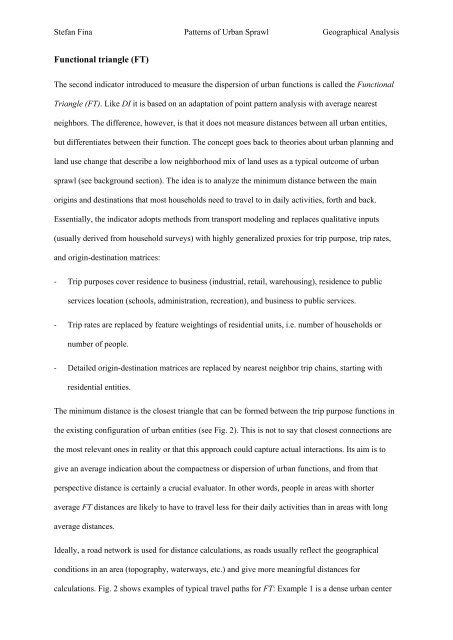PDF 20.134kB - TOBIAS-lib - Universität Tübingen
PDF 20.134kB - TOBIAS-lib - Universität Tübingen
PDF 20.134kB - TOBIAS-lib - Universität Tübingen
Erfolgreiche ePaper selbst erstellen
Machen Sie aus Ihren PDF Publikationen ein blätterbares Flipbook mit unserer einzigartigen Google optimierten e-Paper Software.
Stefan Fina Patterns of Urban Sprawl Geographical Analysis<br />
Functional triangle (FT)<br />
The second indicator introduced to measure the dispersion of urban functions is called the Functional<br />
Triangle (FT). Like DI it is based on an adaptation of point pattern analysis with average nearest<br />
neighbors. The difference, however, is that it does not measure distances between all urban entities,<br />
but differentiates between their function. The concept goes back to theories about urban planning and<br />
land use change that describe a low neighborhood mix of land uses as a typical outcome of urban<br />
sprawl (see background section). The idea is to analyze the minimum distance between the main<br />
origins and destinations that most households need to travel to in daily activities, forth and back.<br />
Essentially, the indicator adopts methods from transport modeling and replaces qualitative inputs<br />
(usually derived from household surveys) with highly generalized proxies for trip purpose, trip rates,<br />
and origin-destination matrices:<br />
- Trip purposes cover residence to business (industrial, retail, warehousing), residence to public<br />
services location (schools, administration, recreation), and business to public services.<br />
- Trip rates are replaced by feature weightings of residential units, i.e. number of households or<br />
number of people.<br />
- Detailed origin-destination matrices are replaced by nearest neighbor trip chains, starting with<br />
residential entities.<br />
The minimum distance is the closest triangle that can be formed between the trip purpose functions in<br />
the existing configuration of urban entities (see Fig. 2). This is not to say that closest connections are<br />
the most relevant ones in reality or that this approach could capture actual interactions. Its aim is to<br />
give an average indication about the compactness or dispersion of urban functions, and from that<br />
perspective distance is certainly a crucial evaluator. In other words, people in areas with shorter<br />
average FT distances are likely to have to travel less for their daily activities than in areas with long<br />
average distances.<br />
Ideally, a road network is used for distance calculations, as roads usually reflect the geographical<br />
conditions in an area (topography, waterways, etc.) and give more meaningful distances for<br />
calculations. Fig. 2 shows examples of typical travel paths for FT: Example 1 is a dense urban center

















